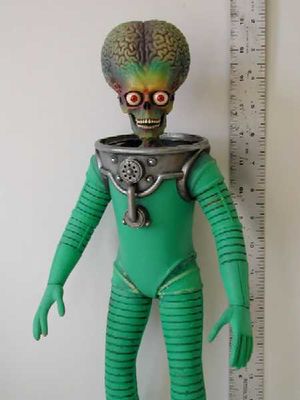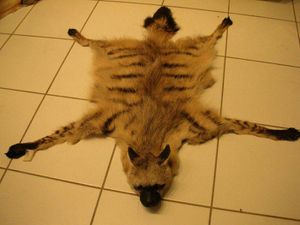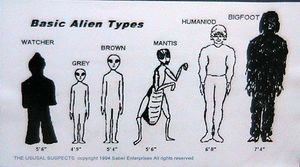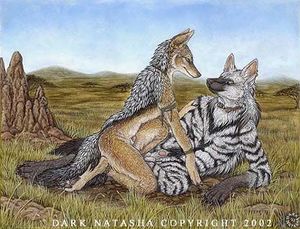Aardwolf
| Aardwolf | |
|---|---|
| Scientific classification | |
| Kingdom | Middle Earth |
| Phylum | Easy Listening |
| Class | Remedial |
| Order | Starter |
| Family | Nuclear |
| Genus | Martianovore |
| Species | Northern, Southern, Cornish |
| Binomial name | |
| Aardimus Minimus | |
| Specifications | |
| Primary armament | Rocket-Propelled Grenades |
| Secondary armament | Flick knife |
| Power supply | 24 volts |
| Health | 46 |
| Mana | 12 |
| Strength | Good personality |
| Intelligence | IQ 60 |
| Weight | Anorexic |
| Length | 12" when erect |
| Special attack | Vulcan death-grip |
| Conservation status | |
| Threatened by the meaninglessness of life | |
The aardwolf is a small, Martianivorous hyena-like mammal, native to East Africa, Southern Africa and Cornwall. The name means "earth wolf" in Afrikaans and “death-pig” in ancient Celtic. Unlike other hyenas, the diet of the aardwolf almost completely consists of aliens, insect larvae and pizza.
Three geographically separate subspecies are recognized: Proteles cristatus cristatus of Southern Africa, Proteles cristatus septentrionalis of East Africa and northeastern Africa, and Proteles cristatus bodminus of south western England. It is usually placed in the Hyaenidae along with spotted and brown Hyena and Fruitbats.
The aardwolf lives in the scrublands of eastern and southern Africa. These are the areas of land covered with stunted trees or shrubs and prone to alien incursion. The aardwolf hides in a burrow during the day and comes out at night to search the night sky for tell-tale lights. It is related to hyenas, but unlike its relatives, it does not hunt large prey, leaving Daleks and Cybermen to more robust predators such as the Meerkat. This unusual animal is a mass killer-of Aliens. It feeds mainly on Martians and can eat more than 200,000 in a single night, using its long, sticky tongue to collect them through tiny holes in the superstructure of their UFOs.
Physical characteristics[edit | edit source]
The aardwolf looks most like the Striped Hyena, but is significantly smaller with a more slender muzzle, sharper ears utilized in the hunt for aliens, black vertical stripes on a stylish coat of yellowish fur, and a long, distinct mohawk down the middle line of the neck and back, which is raised during a confrontation to make the aardwolf's size appear bigger.
It is 55–80 cm long, excluding its bushy 20–30 cm tail, stands about 40–50 cm at the shoulder – and up to 2 metres when in heels. The average Aardwolf weighs between 9 and 14 kg, though peer-pressure has caused a rise in teenage Aardwolf anorexia.
Its front feet have 5 toes, unlike other hyenas which have four toes – this makes Aarwolves think themselves pretty special but leads to social ostracism – the aardwolf is always the last hyena asked to dance.
Its teeth and skull are similar to that of the hyena, although the cheek teeth are specialised for eating Martians, and its tongue for licking them up. As the Aardwolf ages, it will normally lose some of its teeth in fist-fights, though this has little impact on their feeding habits due to the soft nature of the Martians they consume. It has two glands at the rear that secrete a musky fluid for marking territory and communicating with other aardwolves, or that’s what they tell their mothers, anyway.
Distribution and habitat[edit | edit source]

The aardwolf lives on open, dry plains and caravans, while avoiding mountainous areas. Due to its specific food requirements, the animal is only found in regions where Martians occur. Aliens of this family depend on dead and withered grass to make lasting crop-circles and are most populous in heavily grazed grasslands and savannahs, including farmland. For most of the year, aardwolves spend time in shared caravans consisting of up to a dozen dens which are occupied for up to six weeks on a time-share basis.
There are three distinct populations: one in Southern Africa, and another in East and Northeast Africa. The Cornish sub-species is distinct, supplementing its alien diet with pasties and grockles. Its recent decline is thought to be linked to the strength of the British pound over recent years detering aliens.
Behaviour[edit | edit source]
Aardwolves are shy and sexy, sleeping in underground burrows by day and parading in hotpants by night, They usually use existing burrows of aardvarks, Old World porcupines or Earthworms, despite being capable of creating their own as digging is uncool and can damage their nail-varnish.
By night, an aardwolf can consume up to 200,000 aliens using its sticky, long tongue. They take special care not to destroy the UFO or consume the entire colony, which ensures that the aliens can return and provide a continuous supply of food. They will often memorise and return to landing-sites to save the trouble of finding a new one. Apart from Martians they are also known to feed on other aliens, larvae, and eggs, and occasionally small cars and dinosaurs. Unlike other hyenas, aardwolves do not scavenge or kill larger animals, or attempt to foment political unrest in the human populations they live among.
The adult aardwolf is primarily solitary while foraging for food, necessary because of the scarcity and homogeneous distribution of their alien prey. They have often been mistaken for solitary animals. In fact, they live as monogamous pairs, with their young, defending the same territory and only occasionally visiting swingers’ clubs to spice up their otherwise monotonous lives. Young aardwolves generally achieve sexual maturity after two years in order to seek a council flat., The breeding season varies depending on their location, but normally takes place during the autumn or spring. During the breeding season, unpaired male aardwolves will search their own territory as well as others' for a female to mate with, or will otherwise form civil partnerships with each other. Dominant males will also mate opportunistically with the females of less dominant neighboring aardwolves, with shrubs and with the legs of passing herd-boys.
Gestation lasts between 90 and 110 days, producing one to five cubs (most often two or three) during the rainy season, when aliens are active. The first six to eight weeks are spent smoking in the den with the mother. After three months, they begin supervised foraging for cigarette ends and by four months are normally able to roll their own. However, they will often use the same tobacconist as their mother until the next breeding season. They can achieve a life expectancy of up to 15 years when in captivity, 75 years in countries with higher levels of social welfare.
Interaction with humans[edit | edit source]
The aardwolf has taken advantage of the development of agriculture in the continent. [Citation not needed at all; thank you very much] They are often considered useful, non-dangerous animals by farmers. However, in some areas the aardwolf is hunted for its fur. Encounters with dogs are another threat, as is Swine flu, SARS, AIDS and disintegration rays.



